Bourbon Snobbery
The noted wine critic Robert Parker recently forayed into reviewing bourbon and came under intense fire from enthusiasts of American whiskey.
The noted wine critic Robert Parker recently forayed into reviewing bourbon and came under intense fire from enthusiasts of American whiskey.
In his essay, Parker notes that Pappy Van Winkle is “the most difficult alcoholic beverage to find in the United States. If you think I’m joking, try and find a bottle, especially of the 20-year-old and the very rare 23-year-old bourbon. They are much more difficult to find than esoteric and limited production French wines such as Romanée-Conti, Montrachet or Petrus.” He adds, “What started as a fun distraction to see what was so special about Pappy Van Winkle led to a full throttle inspection/conquest of bourbon. To tell you the truth, I have never been a big fan of liquor, but I was blown away by the quality of the top bourbons. They are every bit as good as a great cognac or Armagnac … and I’m not kidding!”
While true and seemingly innocuous, this drew the ire of Scotch and Ice Cream‘s Tim Read who terms Parker a “professional Napa douchebag” and implores, “Git Offa Our Property, Parker!” While admittedly not much of a wine drinker, Read finds the whole wine scene and “the sheer douchebag factor of guys in their 60s tooling around in Porsches with chinos and checked oxfords dangerously unbuttoned at the collar, made safe by the addition of a blazer” pathetic. In particular, he’s not a fan of the “deferential and reverent mention to what Parker thought – as if his taste is more relevant than your own.”
As to Parker’s foray into whiskey reviewing, Read’s sensibilities are offended by the notion that rarity and price should be the prime considerations.
Apparently the wine world regards scarcity as a measure of quality. I hope Parker very quickly clues into the rich-asshole-targeted Dalmore Constellation Collection; those are extremely limited and they must be fantastic since they’re so hard to find. (Have you ever seen one in the stores?) Also, Brechin isn’t common. You ought to stock up on that shit post-haste. It closed 30 years ago! BUY NOW.
Parker goes on to discuss how Bourbon, despite what all the Schwab branch office guys are predisposed to think, is actually perhaps worth giving some attention to. Apparently Johnny Reb’s firewater made from mostly corn is worth consideration, as long as it’s rare and priced highly.
Sour Mash Manifesto‘s Jason Pyle is similarly annoyed at the “shocker” that bourbon can be every bit as good as cognac and bemused that Parker describes Blanton’s as either “a masterful blend or a bourbon of serious age” when his own readers “all of course know that it’s neither.”
Chuck Cowdery weighs in at his eponymous blog with “God-Like, Robert Parker Conquers (His Word) Bourbon in One Fell Swoop.” He admires Parker as a taster, chides his use of a 100-point scale on which nothing scores below and 82, and finds his choice of whiskies to compare odd:
He also does not appear to know nor care that it’s insane to compare Hudson Baby Bourbon to Pappy Van Winkle 23 just because they both have the word “bourbon” on the label. Would he compare a Pinot Noir to a Sauterne? Not without at least noting their inherent differences first.
He also scoffs at Parker’s lack of knowledge about distilleries and their mashbills, making fun especially of Parker’s fondness for products of Black Mapel Hill Distilling which is “an entirely fictional distillery.” (Cowdery doesn’t explain what he means, since his readers know. But, yes, there’s a common practice in the bourbon trade of inventing niche distilleries to hide the fact that several different bottles all contain pretty much the same whiskey at widely different price points.)
Along the same lines, Read not unreasonably chides Parker for weighing in as though he were an expert when he’s a rank novice. In particular,
Parker seems to fall for the common trap that “older is better” and rates Pappy 23 a 100%, tacitly blessing all of the fanboy bullshit that surrounds Pappy, age in general, and the overrated mythos of Stitzel-Weller. Parker also tells us in his notes that “top bourbons” should never be “diluted or served on ice”. Oh, really?
Hey Bob, did you know that Van Winkle 23 is about 47% ABV which is considered “towards the low end of ABV” in our scale? Any clue that people regularly will drop a little ice or water in their blisteringly-high-proof single cask scotches or bourbons and find a massive explosion in flavor? It’s extremely common, and if you’d spent any time whatsoever learning the culture and truly tasting whisky and learning about the spirit, you’d know that it’s not at all taboo in those cases. Instead, you’ve taken what amounts to a five-minute noob-comment-driven crash-course on Reddit and are now spreading it to a bunch of uninterested assholes as gospel truth. Why don’t you hop on the “bourbon can only be made in Kentucky” bandwagon while you’re at it? It’s as tone-deaf and factually ignorant as what you professed. Maybe you saw Paterson saying he’d “kill you” for putting ice or water in your whisky, but that’s because Paterson’s whiskies are already pretty fucking watery unless you’re spending $2000.00 for a cask strength bottle.
Now, I’m with these guys that, in the end—with whiskey as with wine—what matters is what the individual taster likes. Reviews can be helpful in selecting what to try, but the point should be an enjoyable drinking experience, not social status. But they’re too hard on Parker here. People who subscribe to wine reviewing magazines tend to be interested in rarity and building collections; introducing the notion that bourbon has these qualities likely piques their interest. And, while it may be insulting to bourbon enthusiasts, there’s a widespread misconception out there that cognacs and Scotch whiskey are the finer spirits while bourbon is cheap rotgut to be mixed with one’s Coca-Cola. Parker is helping to dispel the notion.
While I’ve been drinking bourbon longer than Parker, I’m still a relative novice. I was pretty exclusively a Scotch guy until a year or so ago and only started drinking Scotch maybe five years ago. Now, unlike Parker, I therefore don’t presume to review whiskies.
But, for example, until Keith Boyea and some others of my Twitter friends convinced me to try some of the better brands, I always thought that bourbon all tasted like Jim Beam (white label), which is to say, sickly sweet. In actuality, there’s almost as much variation in bourbons as there is in Scotch. Naturally, because I started with Scotch, I assumed that age matters a lot. But bourbons achieve peak flavor a lot more quickly, so it’s not necessarily so.
Because I got on the bandwagon late, I’ve never had the Pappy Van Winkle. It’s just impossible to get and, from all accounts, not worth the grossly inflated prices that come with that rarity. Indeed, that very fact seems to be part of what set off Read and company. Clay Risen of Mash Notes builds on that theme with a post titled “Robert Parker and the Douche-ification of Bourbon.” He’s inclined to cut Parker some slack as a newbie but worries about the impact of his message.
What I think both Read and I – and many others – don’t want to see happen is a repeat of the Pappy Van Winkle hype story. Don’t get me wrong, I think the Pappy portfolio is fantastic. The 23 year old may be the best whiskey out there; I vacillate in my own opinion, but it’s certainly a contender. Up until a few years ago, you could easily find most Pappy expressions, at relatively cheap prices. Then, suddenly, it started to get hype, particularly among those people who confuse wealth for class and rarity for quality – the very people who have made Parker an icon. Now it’s as rare as turkey teeth, and on Wall Street having a bottle or two is a status symbol. People brag about Pappy, beg for Pappy, in terms wholly out of proportion to the way old-timers used to see it. Worst of all, those of us who used to like buying a bottle every now and then can’t, because all the bottles in town have been bought up by the Wharton Club of New York.
How long will it be before this same thing happens to other delicious, low-hanging fruits – Parker’s Heritage, Elijah Craig 20, the upper-end Four Roses, and so on?
Since I’m now a steady consumer, I join in hoping this doesn’t happen. Indeed, I drink a lot less Scotch these days not only because I’m enjoying my foray into bourbon but because the status value of the former has contributed to jacking up the price. The Macallan line, in particular—my favorite—has been especially hard hit. The basic 12-year-old Sherry cask expression, which was available in these parts around $48 a bottle just a couple years back is now going around $63. The 10-year Cask Strength, which is my favorite, has gone from $70 to over $95 in that same span. The 18-year is now over $150 and the 25-year is in the $1000 range.* I own a bottle of the former for special occasions and can’t imagine the circumstances under which I’d acquire the latter.
Despite the emergence of a “bourbon bubble” in recent years, with the Pappy craze the most obvious example, American whiskies remain a comparative bargain. The widely available Four Roses expressions (80-proof Yellow Label , 90-proof Small Batch, and 100-proof Single Barrel) remain a relative steal, with the various limited edition releases much more expensive and hard to locate. One of my favorites is Booker’s, the 126ish-proof barrel strength expression from the folks at Jim Beam, which rivals the Macallan Cask Strength for around $55. And Boyea tipped me off to some under-$15 bottles, my favorite of which is the 100-proof Evan Williams White Label, that I would never have deigned to try precisely because they were so inexpensive.
If you’re a true connoisseur of bourbon or Scotch or wine or whatever, you probably spend a lot more time learning about those products than the average Joe who just drinks the same brand all the time. Most newbies, myself included, are happy to be educated. There’s no call for condescension, though. Why wouldn’t Parker start with the assumption that Pappy Van Winkle 23 is the best bourbon on the planet? That’s a widely held view. So, it’s fine to tell him that there are a dozen bottles of easily obtainable bourbons that are as good or better at a quarter of the price. But sneering seems uncalled for.
Rating systems like Parker’s can be helpful to uneducated consumers—which is to say, almost all consumers. There’s a bewildering array of choices out there. I’ve been drinking big red wines long enough to know what varietals and regions I tend to prefer, but will indeed look at the ratings cards for guidance when selecting between labels I don’t know. I know I tend to like Highland and Speyside Scotches and will happily take suggestions from expert reviewers as to which new-to-me varieties to try. I’m less educated on bourbons and happily take suggestions along the lines of “Well, if you like Booker’s and Four Roses Small Batch, you should really try ______.”
Ultimately, though, Pyle’s recent posts on hoarding whiskey strikes me as the right note to take. The point of acquiring new bottles of whiskey is to enjoy them, not store them away so that you can brag about what’s in your collection. If I ever come into possession of a bottle of the Pappy 23, I’ll be drinking it, not staring at it on a shelf.
*Originally, I had it at $600. But the Virginia ABC stores sell it at $999 and I’m not finding it in any of online catalogs of the DC stores for much less than that. I’m guessing it was the 21-year Macallan Fine Oak edition that I was seeing at $600.
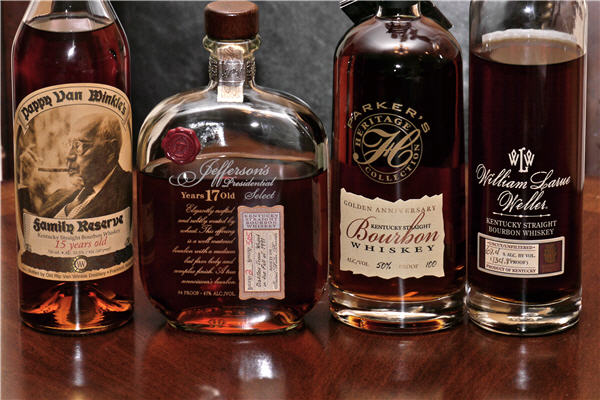

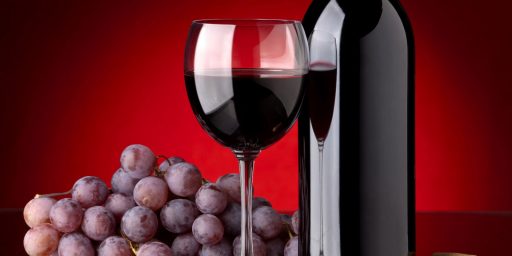
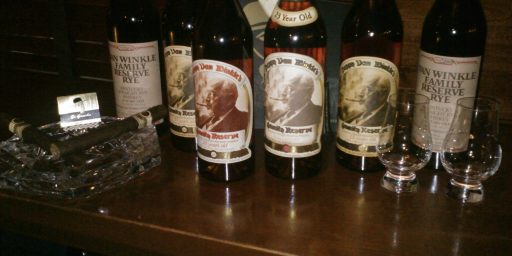
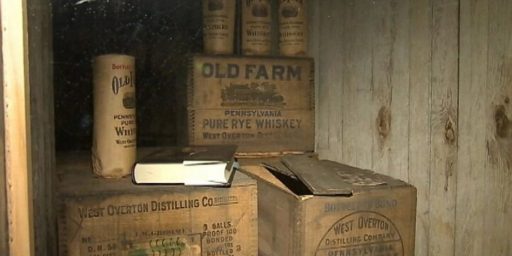
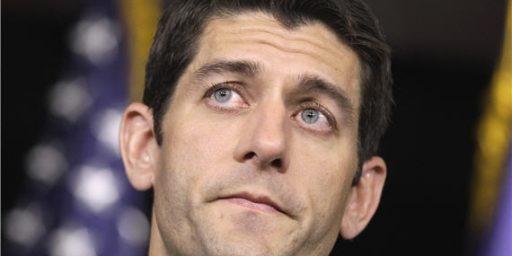
Many of my bourbon friends got all worked up about this and I guess I get it. Mr. Parker doesn’t seem to know much about bourbon and he’s got a big platform.
On the other hand, when I go to big bourbon gatherings with hardcore bourbon enthusiasts, no one drinks Pappy because there is too much other great and interesting stuff out there. Four Roses, for example, is consistently putting out products that I enjoy as much as any PVW. (And they have 10 different recipes so you can spend years figuring out which one you like best.) As I’ve learned more and more about bourbon over the last several years, I’ve found that a lot of the fun is in finding what I like to drink. I like Evan Williams BiB–it’s $12.95 at VABC. I also like Old Grand Dad 114 (~$22), Rittenhouse Rye ($20) and Old Weller Antique ($25). Noobs can search for Pappy all day and night–I’ll just sit here on the couch drinking those four whiskies (and save a bunch of money too.)
Of course, that’s all easy for me to say: I’ve tasted, owned and drank most of the Pappy expressions. It really is worth trying–I recommend trying it at a bar. It is expensive, but far less expensive and less time consuming than trying to find a bottle. Matchbox, Ted’s Bulletin, Senarts, and various other places around town typically keep a bottle behind the bar.
@Keith Boyea: I guess I get it, too, although Parker’s intro makes it pretty clear he’s not an expert. He get intrigued by Pappy’s because of some TV show, went on a quest to find it, and then decided to start branching out. That’s pretty much the definition of a newbie.
I bought the Evan Williams Bottled-in-Bond (aka., White Label) along with an Evan Williams Single Barrel, which came with a sample of the Evan Williams Larceny offshoot. The B-i-B was not only my favorite of the three but had the bonus of being both much cheaper and higher proof.
Indeed, often my best guide to what I’ll like is the proof (aka, ABV or alcohol by volume). I almost always prefer the higher proof version of a given distillery’s product. For example, I find Beam White Label almost undrinkable and the Booker’s fantastic despite both being essentially the same brew.
I tried the orange label Old Grand Dad, which I believe is 80 proof, and like it. I’ll definitely give the 114 a go.
Where in the world did you find Macallan 25 for $600? I was at the ABC store yesterday and they had it for $999. Holy. Crap.
Macallan’s pretty good, no doubt, but my favorite scotches lately come from Ardbeg.
If you can find it, try some J.T.S. Brown. It was the only bourbon Frank Sinatra would drink.
@Mikey: I swear I saw it in DC for $600 or so; the VA ABC is indeed selling it for $999.99. Maybe it was some younger bottle, but I don’t think there’s anything between the 18 (usually $150 to $175) and the 25, at least in the sherry cask expression. I’m not a fan of the fine oak variety.
Around here Rock and Rye is a huge seller. It is the #1 medicine for coughs and soar throats. Cuts throat build up and burns away laryngitis. Great for sleep.
@Keith Boyea: – My God, it’s like reading one of my own posts about bourbon. I agree with everything you said, except about the Old Weller (didn’t stand out as special to me). The problem with Rittenhouse is that it’s so good and so inexpensive that I’ve never seen a place keep it in stock for more than a week. Four Roses is similar, but (so far at least) not “discovered” out here in Seattle. Old Grand Dad 114 is also exceptional, and also very difficult to find out here.
I start to get diminishing returns on bourbons that go over 120 proof, for me at least the high alcohol levels start to numb the senses rather than excite them.
@HankP: The Booker’s varies from bottle to bottle but is usually in the 126-129 range. I sometimes cut with a splash of water but usually take it neat.
Virginia ABC sells at a big markup compared to non-monopoly stores like the DC liquor stores. I like cognac. A 750ml Courvoisier VSOP costs $40 at VABC, and the same bottle is $25 at Calvert-Woodley in DC.
@DC Loser: Yes, I’ve got to shop more in DC. The problem is that in the K Street/15th Street area where I work, prices are comparable to VABC. I’ve had better luck further out but it’s much harder for me to shop there since it would involve driving and parking. Scanning the bourbons at Calvert Woodley, though, the prices aren’t radically cheaper. The single malt Scotch selection, though, appears to be considerably lower priced.
And then there’s the new Costco in DC (off NY Ave near the BW Parkway). It’s the only Costco in this area that sells liquor.
@Mikey: I’m guessing what I saw was the 21-year Fine Oak. I’m not seeing the 25-year Sherry Oak anywhere in the $600 range.
@DC Loser: I definitely give that a try. My brother-in-law sometimes brings Macallan down from the Connecticut stores.
I’ve been drinking bourbon for about a decade, but I’ve never really been a “bourbon drinker”. What’s the communities opinion on Boubon Manhattans?
@James Joyner: Hey James –
Thanks first for the mention in all of this silliness. It’s been very interesting to learn more about wine culture in the last few days and see how there’s some similarity there. I think ultimately, to me, it’s just silly to think you can come into something you have at best a fleeting familiarity with and proclaim perfection. I’ve got no problem with orienting yourself on the map by trying what are regarded as fine bourbons. It’s also unsurprising to say that you’d love some of them. Still, it’s a bit early in his journey to claim conquest and have laid down decisive scores on “best of the best”. Ten years ago, I might have said Gentleman Jack was just an unbelievable whisky because it’s “smooth”. Now, I just see it as filtered and dull. There’s so many things to discover, not least of which is just getting a healthy base of whiskey experience, that I think claiming you know perfection in a year is off the mark. I’ve been drinking whiskey for ages and I still haven’t had anything I’d consider perfect.
As to the Macallan price thread – Big Mac just bumped their prices. Expect $200 as the new norm for 18 and $1K seems a bit gouge-y for the 25, but I wouldn’t be surprised in the least to find that’s the new price. With their new Gold/Ruby/Amber/Sienna NAS scheme, I also don’t know how long Fine Oak will hold on.
And on the Manhattan side of things… sweetness is tough for me in the sense that a little goes a long way. Vermouth can just be too cloying for me, which is why I like a nice rye (Ritt, High West, Sazerac) to act as a balance. However, rye can be a bit too piney, so if you want the sweeter bourbon experience, what’s to stop you? (No judgement!) That said, I found myself really enjoying High West’s barrel aged Manhattan, though I’m not really a big cocktail guy.
@Tim Read:
Well, I’m a traditionalist who still puts bitters in their Manhattans, to control that. My standard pre-meal cocktail is a Makers Mark Manhattan, up with bitters.
Bookers is great, but dangerous. I once made the mistake o ordering a double, followed by a double an hour or so later. When I had finished it, I remarked the ground was rumbling like a train was coming. The next morning I was under sure that a train had hit me the night before.
I’ve strayed from drinking scotch for a few years, doing mostly bourbons, however this weekend I tried a flight of some of Glenmorangies rarer expressions. Of you get a chance try the Quinta Ruban and Astar. Truly phenomenal stuff.
@Stormy Dragon:
I prefer Irish whiskey manhattans to bourbon, but bitters are key either way.
What do people recommend as top quality bourbons? the only non-rotgut I’ve tried has been Jack Daniels.
The pricing for the 25 McCallan is $999 here in Illinois as well. I’ve promised myself to get a bottle after selling my first company for over $50M.
@Neil Hudelson: If you ever want a sake that will do the same thing, try Kubota (if you can even get your hands on it here in the US.) Smooth as silk and you don’t realize how much you’ve had until you try to get up and fall flat on your face. One of the best Niigata sakes.
@grumpy realist: It’s a matter of what you like. I’m a big fan of the Four Roses line, especially the 100-proof Single Barrel, which is under $30. Booker’s, the Jim Beam barrel strength expression, goes around $55-60. Eagle Rare ($25ish), Weller 12 year ($30ish), and others are quite good.
@grumpy realist: @James Joyner: Ditto on Eagle Rare. I don’t drink a lot of bourbon, but Eagle Rare came highly recommended as excellent both in flavor and value. I was not disappointed.
@James Joyner: Thanks! I’ll try to pick up a bottle the next time I go to my enormous liquor store down at UIUC. (Only place I know I can get Laphroaig, Oude Janaver, and Tokaiji.)
Now is perhaps a good time for y’all to reread, or read, On Wine Bullshit.
I expect On Bourbon Bullshit to be in the offing.
Oh, and see the classic from which the wine piece derives its name, Harry Frankfurt’s On Bullshit.
The Van Winkle 12-year ($45 in Miss. the last time I found one) is very good.
I just never believe that a $300 dollar bottle of anything is ten times better than a $30 dollar bottle. Probably not even twice as good.
I live in Louisville, and 95% of Bourbon is made within about 60 miles from here. So, this is a large and very old market for the spirit. A couple of points: age does not translate to quality, only to rarity. After all, how did the Van Winkle folks know how much to produce back in 1990 for their 23 year old sales in 2013? Some excellent bourbons don’t even put the age on the label because it is irrelevant. Why? Because Bourbon is ready when the Master Distiller says so, not because the calendar says so. The process of moving the whiskey through the charred oak staves season after season is what smoothes the liquor. And makes it great. The widely variable seasonal temps in Central Kentucky is the key factor in that. Smart, experienced, value conscious DRINKERS here favor an old brand that you won’t even find outside Kentucky (at least I have not) but which happens to be very fairly priced, below the “premium” brands, and was the first bottled Bourbon. Remember the introduction of Woodford Reserve? Guess what was in the bottles before full production at the distillery was up to capacity and ready for consumption? It wasn’t whiskey from the copper pots made famous at the Glenn’s Creek site. It was the “first bottled whiskey” that they put in those early bottles of Woodford. And it still has George Garvin Brown’s signature on the bottle. And by the way, Jack Daniels isn’t Bourbon, and it isn’t made in Kentucky. It is Tennessee Sour Mash Whiskey made in Tennessee.
@Greg chapman: Interesting discussion. Are you referring to Old Forester? It’s pretty widely available.
And, yes, Jack Daniel’s is a bourbon. Daniel’s, like George Dickel and other Tennessee Whiskeys, are charcoal filtered using something called the Lincoln Country Process. But it’s a sub-classification of bourbon. Being made in Kentucky isn’t necessary to quality as a bourbon. The only requirements for a spirit to qualify as a bourbon are being made in the United States and
-made from a grain mixture that is at least 51% corn
-aged in new, charred-oak barrels;
-distilled to no more than 160 proof (80% alcohol by volume);
-entered into the barrel for aging at no more than 125 proof (62.5% alcohol by volume)
-and be bottled (like other whiskeys) at 80 proof or more (40% alcohol by volume).
@Stormy Dragon: Bourbon manhattans are excellent (as are Rye whiskey manhattans). No need to go for a very high end product, because you’ll be adding some other spirits. The key is actually good sweet vermouth, Antica Formula Carpano Vermouth is a really good one. Very flavorful and smooth. And then add a few dashes of bitters; Fees has a barrel aged bitters that is great for manhattans. Good on the rocks or strained.